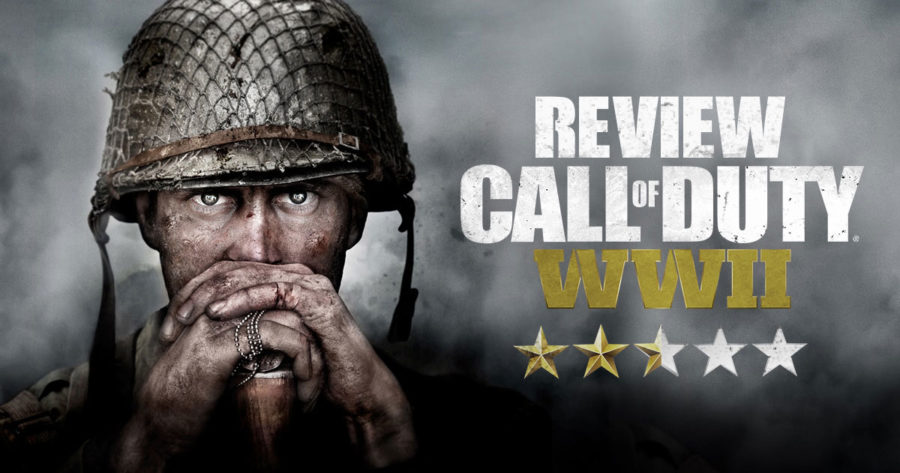Call of Duty: World War 2 reminds players just how horrible war really is
With every new year that comes about, a new edition of the Call of Duty franchise does too. This year’s edition, known as Call of Duty: World War 2, is a fresh installment of the previously common aspects of the Call of Duty games, such as reflecting actual war and social issues of the time. While being only a mere video game, the Call of Duty franchise is an ever-growing staple of the current generation’s pop culture, exhibiting the interest of over 100,000,000 people, according to the New York Times, ranging in ages of 10 years old and beyond. The franchise often times appears negatively in the media due to the violence and exhibition of war to being a negative influence on children and young adults. Users should note that COD: WW2 is rated for teens and above.
However, the underlying message of the Call of Duty franchise does not intend to normalize violence. Each new story derives an anti-war motif that highlights the brutality, dishonesty, and horridness of war, but still acknowledges how war is a necessary evil in society. These attributes of the campaign create the tension that keeps players playing while educating them on the complexity of war which plagues modern international society. With Activision’s latest installation, Call of Duty focuses on the second World War, the Nazi Regime, and the tensions between nations and individuals and their own private platoons.
The game’s campaign follows Daniel, a younger man from the United States and his platoon. Respectively, similar to World War 2, the majority of the boys in his platoon are 18 years old. The gameplay is much slower than the previous Call of Duty, due to the removal of certain aspects. For the past four Call of Duties, extreme jumps and high rate rifles have increased the speed of the game, rendering aspects like multiplayer. It has been voided of the patience and planning that originally was an appealing trait of Call of Duty when the franchise was first released. Now, with a much more realistic version of warfare, players are finding a new found appreciation for the more premeditated aspects of the game, such as utilizing a sniper rifle. Activision recognized this too and capitalized upon it. Daniel and his platoon, unlike previous campaigns, aren’t sent into the heart of conflict as much as usual. The campaign for World War 2 has players stay mostly from a distance, fighting the battle with sniper rifles and long-range missiles. While I enjoy this aspect of the game, many players found this boring and uninteresting. Call of Duty has released too many games since their last actually realistic game, establishing a style of gameplay to newer players that solely revolves around fast-paced action. To older players, the pace is a refreshing reminder of the realism that first established Call of Duty.
However, the campaign of Call of Duty: World War 2 pales in comparison to previous campaigns. By creating a new storyline instead of expanding previous ones, the emotional investment into the characters is lost. The campaign also purposely detaches the significance of most characters except Daniel by letting them die shortly after they are introduced.
While this is an important trait to highlight about the war, Activision is warranted the poetic license to dramatize these events to create not only a truthful recounting but an exciting, diligent one as well.Aside from the campaign and the game’s central story, this video game is technically sound. World War 2 follows the same format as any other Call of Duty: multiplayer, campaign, and zombies. Multiplayer dynamics have changed, however.
Multiplayer, like the game’s campaign, does have a heavy emphasis on patience. Multiplayer maps are larger than normal, and without the ability to jump great distances or speed around the map via some futuristic vessel, players are left running long distances to have an exchange with another player. These exchanges, however, are superiorly more exciting than any other Call of Duty experience. After so many fast-paced editions of the game, the expectation for multiplayer is that players never expect when they are going to be attacked and ambushed. World War 2 removes this; without the intense jumps and extraneous technology, players are left competing truly based off of raw talent. Confrontations are now longer, rendering them more thrilling than ever.
Zombies, like the game’s multiplayer and campaign mode, is just as suspenseful. Within the Call of Duty franchise, Zombies is a keystone aspect that gives players a frightening shrill of joy. Activision rotates game developers with each new Call of Duty, and the game developers known for creating zombies is Treyarch. However, Treyarch is not developing this edition to the franchise, Sledgehammer Games is. For Sledgehammer Games to venture out and develop an aspect of Call of Duty that they have no experience with is risky, especially when players nearly worship Treyarch’s version of Zombies. Luckily, Sledgehammer Games was able to develop an almost as exciting zombies experience as the previous Call of Duties. With a new soundtrack that is more suspenseful than ever, Zombies is able to recreate the original scare that players experienced when they played their first round. The one thing that Sledgehammer Games is missing, though, is the continuous storyline that Treyarch’s Zombies has been developing for the past 8 years. Players are deeply invested, and the transition to a new story with new characters is always tricky.
While the game still needs and is receiving updates in order to patch certain glitches, World War 2 is a structurally-sound and above average edition of the Call of Duty franchise. The game is neither lackluster nor as impactful as others, however, it is a refreshing splash of the Call of Duty veteran players originally came to love.





